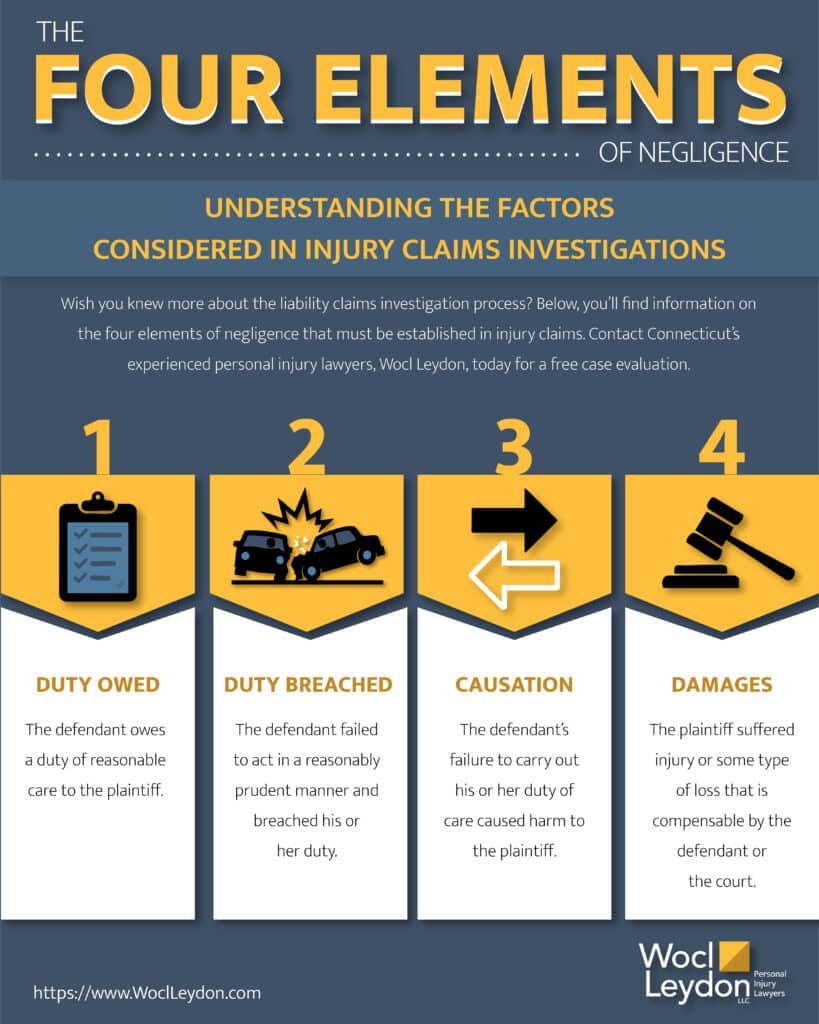How to Prove Negligence: A Guide for Personal Injury Cases
Last updated Monday, June 2nd, 2025

To prove negligence in a personal injury case, you must establish four elements: duty of care, breach, causation, and damages. This article will explain how to prove negligence through these elements and guide you on the necessary evidence to build a strong case.
Key Takeaways
- Proving negligence in personal injury cases requires demonstrating four key elements: duty of care, breach of duty, causation, and damages.
- The ‘reasonable person’ standard is used by courts to evaluate whether the defendant acted with the expected level of care in the given circumstances.
- Understanding comparative negligence rules is essential, as they dictate the extent of compensation an injured party can recover based on their level of fault in the incident.

Get Your FREE Case Review,
In Person or Virtually Online
Understanding Negligence in Personal Injury Law
Negligence is a cornerstone of personal injury law. It refers to the failure to exercise reasonable care, resulting in harm to another person. In most personal injury cases, establishing the other party’s fault can determine the outcome of the case. Whether it’s a car accident, a slip and fall accident, or a wrongful death case, establishing negligence is essential to maximize the compensation that can be recovered for the injured party.
Courts use the “reasonable person” standard to evaluate whether negligence has occurred. This standard compares the defendant’s actions to those of a hypothetical responsible party under similar circumstances. Did the defendant act in a way that a reasonably prudent person would have? If not, they may be found negligent. This comparison is grounded in societal expectations of reasonable behavior.
In essence, negligence is about failing to act with the care that society expects under specific circumstances. Understanding this concept is the first step in building a strong personal injury case. Proving negligence establishes the other party’s legal responsibility for your injuries, allowing you to recover damages for your suffering.
The Four Elements Required to Prove Negligence
Proving negligence in personal injury claims requires demonstrating four specific elements: duty of care, breach of duty, causation, and damages. Each element is crucial in establishing the defendant’s legal responsibility for the plaintiff’s injuries.
- First, establish that the defendant owed you a duty of care, meaning they had a legal obligation to act in a certain manner toward you.
- Second, prove that the defendant breached this duty by failing to exercise reasonable care and that the defendant’s actions contributed to the need to establish liability.
- Third, demonstrate that the defendant’s actions were the actual and proximate cause of your injuries.
- Finally, show that you suffered damages due to the defendant’s breach.
Understanding these four key elements helps in constructing a solid case for negligence. Delving deeper into each element will show how they come together in proving negligence.
Duty of Care in Personal Injury Cases
Duty of care is the legal obligation requiring the defendant to act in a particular manner toward the plaintiff. This obligation can arise from specific relationships or circumstances, such as the duty of a driver to follow traffic laws. For instance, a driver who fails to stop at a red light breaches their duty of care, potentially leading to a car accident.
A judge typically determines whether a duty of care exists in a negligence case, considering the relationship between the parties and the foreseeability of harm. This legal duty is fundamental in personal injury cases because it sets the standard for the defendant’s behavior.
Breach of Duty of Care
After establishing a duty of care, the next step is to prove the defendant breached this duty. This involves showing that the defendant’s actions fell short of what a reasonably prudent person would have done under similar circumstances. For example, leaving nails scattered on the floor in a premises liability case demonstrates a failure to act reasonably.
Proving a breach of duty is crucial as it directly links the defendant’s conduct to the plaintiff’s injuries. Contrasting the defendant’s actions with those of a reasonable person highlights the breach of negligence that led to the accident.
Establishing Causation
To establish causation, it must be shown that the defendant’s actions were both the actual cause and the legally recognized proximate cause of the plaintiff’s injuries. Actual cause refers to the direct link between the defendant’s conduct and the plaintiff’s injuries, while proximate cause addresses the foreseeable consequences of those actions.
Substantial evidence is often required to prove causation. For instance, surveillance footage can provide critical visual evidence regarding the incident’s same circumstances. Such evidence is essential in demonstrating the link between the defendant’s actions and the plaintiff’s harm.
Demonstrating Damages
The plaintiff must prove actual harm that is legally recognized, such as physical injuries or property damage, to claim non-economic damages in a negligence case. The plaintiff’s injury must be a foreseeable result of the defendant’s actions, with a direct link between them.
Medical records showing medical treatment needed due to the auto accident can strongly support the causation claim. Factors determining the recovery amount in a personal injury claim include proving negligence, documenting damages, and considering medical costs, medical bills, and medical expenses.

Get Your FREE Case Review,
In Person or Virtually Online
Types of Evidence Needed to Prove Negligence

Reporting the accident to law enforcement secures the scene and provides an impartial account. Photographs of the accident scene, including vehicle positions and injuries, can significantly fortify your case. Collecting contact information from witnesses helps corroborate your version of the incident. Documenting your immediate recollection of the accident aids in maintaining accurate details for future reference, including the police report.
Attorneys play a vital role in gathering evidence, interviewing witnesses, and engaging medical experts to support claims.
Eyewitness testimony, videos/photos, expert analysis, and safety code violations help establish a breach of duty.
Comparative Negligence Rules and Their Impact on Compensation
Comparative negligence rules significantly impact the compensation an injured party can recover. In states with modified comparative negligence laws, recovery is allowed only if the claimant’s fault does not exceed a threshold, typically 50% or 51%. In pure comparative negligence states, individuals can pursue compensation regardless of their fault level.
States with modified comparative negligence reduce compensation based on the claimant’s assigned fault. For example, in Connecticut, if a victim is 25% liable for their accident, they can recover 75% of their damages. The recovery amount is reduced proportionally by the plaintiff’s percentage of fault.
Understanding comparative negligence rules is crucial because they determine the compensation you can recover. Knowing your state’s laws and their application to your case is key to maximizing your recovery.
Steps to Take After an Accident to Strengthen Your Case
A comprehensive investigation of the accident is necessary to be in the best position to prove how and why injuries occurred in accidents. This involves securing relevant evidence and documenting every detail of the incident.
If injured by someone else’s negligence, contacting an experienced personal injury team for free consultations is essential for assisting the injured victim. They guide you through the legal process, ensuring all necessary steps are taken to strengthen your case and maximize your compensation.
The Role of a Personal Injury Lawyer in Proving Negligence
Proving negligence is a critical goal for personal injury lawyers to secure a favorable verdict. They aid in building a strong case and navigating legal complexities.
Personal injury lawyers have the expertise to handle negotiations and litigation effectively. Hiring a personal injury lawyer ensures a dedicated advocate is working to maximize your compensation.
Time Limits for Filing a Personal Injury Claim
In Connecticut, the statute of limitations for personal injury lawsuits is generally two years from the date of the incident. If a personal injury lawsuit is not filed within this time frame, the case will likely be dismissed.
The statute of limitations is crucial in personal injury claims because it bars claims if not filed within the appropriate time frame. Different types of personal injury cases might have specific statutes of limitations that vary by jurisdiction.
Failing to file a personal injury claim within the designated statute of limitations may result in losing the right to seek compensation.
Frequently Asked Questions
What is negligence in personal injury law?
Negligence in personal injury law is defined as the failure to exercise reasonable care, which results in harm to another individual. This legal concept establishes liability for damages caused by careless actions.
What are the four elements required to prove negligence?
To prove negligence, it is essential to establish a duty of care, breach of duty, causation, and damages. Each element must be clearly demonstrated to support a claim of negligence.
What types of evidence are needed to prove negligence?
To prove negligence, it is essential to gather evidence such as witness statements, medical records, photographs, and police reports. These types of evidence collectively establish the necessary facts of the case.
How does comparative negligence impact compensation?
Comparative negligence reduces the amount of compensation a claimant receives by a percentage that reflects their degree of fault in the incident. This means that if a claimant is found partially at fault, their compensation will be lowered accordingly.
What is the statute of limitations for filing a personal injury claim in Connecticut?
The statute of limitations for filing a personal injury claim in Connecticut is generally two years from the date of the incident. It is essential to adhere to this timeline to preserve your right to seek compensation.


